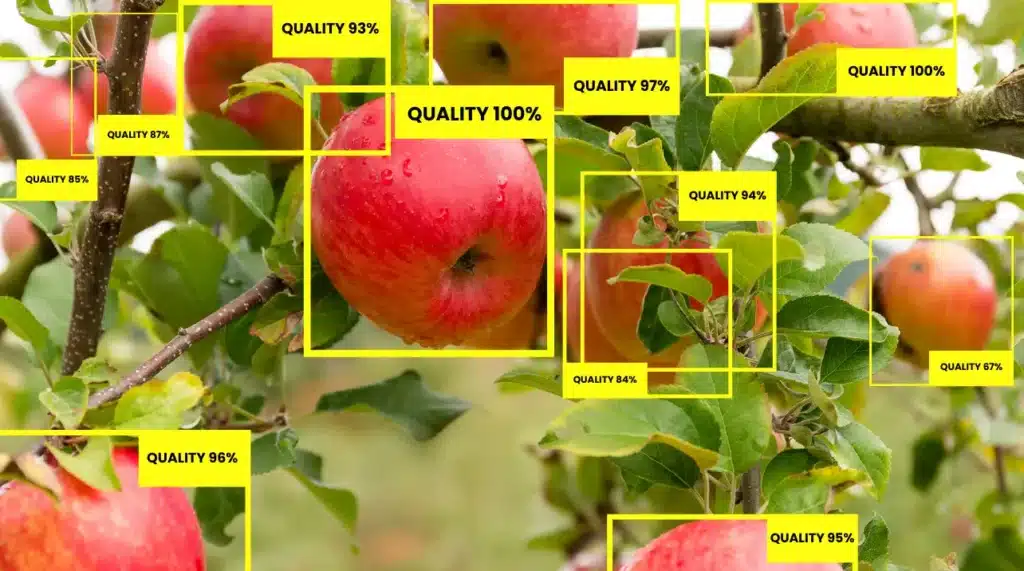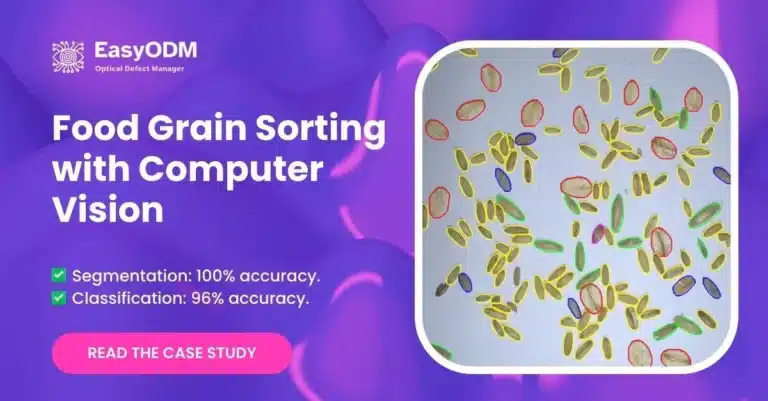Recent technological advancements are streamlining food production and processing. One of the most impactful areas where this is happening is in fruit grading.
Computer vision and AI are now playing critical roles in this space, making fruit grading faster, more accurate, and more efficient than ever before.
Key Takeaways
- Faster Grading: Computer vision grades fruits faster than manual labor. It processes large volumes in less time, boosting efficiency.
- Higher Accuracy: The technology detects defects with more consistency. This ensures high-quality produce reaches the market.
- Advanced Techniques: Modern systems use feature extraction to analyze fruits. Deep learning models categorize them by shape, color, and texture.
- Impact on Consumers: More accurate grading leads to fresher, better-quality produce. It also reduces food waste and improves consistency.
What is Fruit Grading?
Fruit grading is the process of sorting fruits based on quality criteria such as size, shape, color, and defects. Historically, this task was done manually, which was time-consuming and often inaccurate.
Now, computer vision is revolutionizing how we grade fruits, automating the process with far greater speed and precision.
Why Computer Vision in Fruit Grading Matters
Using computer vision for fruit grading offers many benefits. Computer vision can grade fruits much faster than humans. It processes large volumes in a fraction of the time, boosting efficiency in packing facilities.
The technology is also far more accurate than manual methods. It detects defects with better consistency and precision, ensuring high-quality produce. Over time, it reduces labor costs by needing fewer manual graders.
This makes it more cost-effective for farmers. Unlike humans, these systems work 24/7 without breaks. They are reliable and allow continuous operation, boosting productivity.
How Computer Vision Works in Fruit Grading
Computer vision involves several steps in the fruit grading process:
- Image Capture: High-resolution cameras take pictures of fruits from multiple angles.
- Image Processing: Software enhances these images for better analysis.
- Feature Extraction: The system identifies key features like color, shape, and texture.
- Classification: Deep learning models categorize fruits based on these features.
- Sorting: Mechanical systems sort fruits according to their grades.

Case Study: Apple Grading
Researchers have developed a system for grading apples that can detect defects like bruises and insect damage with over 99% accuracy. This system uses a deep learning model called EfficientNet. Apples pass through a lighting box with cameras, where the system captures high-quality images.
AI analyzes these images for defects, and apples are then sorted into either “healthy” or “defected” categories. This system is faster and more accurate than human graders, and it can handle various apple varieties, including Fuji and Golden Delicious.

Banana Ripeness Detection
Another application is determining banana ripeness. Computer vision can classify bananas into four stages:
- Unripe (green)
- Yellowish green
- Mid-ripe
- Overripe
This helps retailers know when to display or discount bananas. It also reduces food waste by ensuring bananas are sold at the right time.

EasyODM’s role in Enhancing Quality Analysis in Agriculture
EasyODM’s grain quality analysis integrates seamlessly with existing agricultural practices, much like fruit grading is done with computer vision. By providing precise data, farmers can make informed decisions that enhance their productivity and profitability.
This approach not only improves quality control but also helps reduce waste, aligning with the broader goals of efficient agricultural practices.
EasyODM offers an innovative solution for grain quality analysis. This technology uses advanced image processing and AI techniques to evaluate grain samples effectively.
Data Augmentation for Better AI
To make visual inspection systems more accurate, researchers use data augmentation. This involves creating new training images by slightly altering existing ones.
For example, flipping the image or changing its color slightly helps the AI recognize fruits in different conditions. Data augmentation helps AI models learn to recognize fruits in various real-world scenarios. This improves overall accuracy.
Ensemble Methods for Improved Accuracy
Some researchers improve grading accuracy by combining multiple computer vision models. This method is known as ensemble learning. By using predictions from several models, the system achieves higher accuracy than a single model could on its own.
Challenges in AI Fruit Grading
While computer vision fruit grading is promising, it faces certain challenges:
- Variability: Fruits can vary significantly, even within the same variety. This natural variability can confuse the AI systems.
- Lighting Conditions: Changes in lighting can affect image quality, making it difficult to grade accurately.
- Cost: Setting up these systems can be expensive initially, especially for small farms.
The Future of Fruit Grading
As technology advances, the future of computer vision in fruit grading looks even more promising. Here are some of the developments we can expect:
- Better Sensors: New sensors will capture more detailed data about fruits. This will help improve grading accuracy even further.
- Smarter AI: More advanced algorithms will allow for quicker and more precise grading. This will make the process even more efficient.
- Multi-Spectral Imaging: This could detect internal defects in fruits, which aren’t visible from the outside. It will enhance fruit quality assessment. Multi-spectral imaging can reveal hidden flaws. This means even more detailed inspections are possible.
- 3D Scanning: 3D scans will provide better analysis of fruit shapes. This technology will allow for more refined grading based on external characteristics. It will further ensure consistency in grading standards.
Impact on Farmers and Consumers
Over time, visual inspection systems reduce labor costs, making operations more affordable. Another benefit is consistent quality. Computer vision ensures uniform standards and lowers the risk of human error. These systems also offer data-driven insights on crop quality. This helps farmers make better decisions.
Accurate grading ensures only the best fruits reach the market. This provides shoppers with a consistent experience. As farmers become more efficient, they can save costs. This may lead to lower prices for consumers. Reducing food waste throughout the supply chain also helps consumers by making fresher, more abundant produce available.
Conclusion
Computer vision is transforming fruit grading by making it faster, more accurate, and highly efficient. As technology advances, the benefits will increase. Both farmers and consumers will gain from smarter, tech-driven agriculture in the future.


